
Cao Lau Hoi An: Origins, Unique Flavors, and the Best Places to Eat
More than just a noodle dish, Cao Lau was once praised by the American magazine Huffington Post as "Vietnam's greatest culinary treasure" and also a symbol of Hoi An’s international trading past. If you are planning a trip to this UNESCO World Heritage Site, understanding Cao Lau and knowing where to find the most authentic bowls is essential for a complete cultural experience. Join Hoi An Memories Land to discover why Cao Lau is a must-try dish when visiting Hoi An.
1. Discover the Origin of Cao Lau – The Culinary Soul of Hoi An
Cao Lau is not merely a dish; it is the culinary embodiment of Hoi An's rich history and multicultural past, making it an absolute must-try for any visitor. Its unique flavor profile and meticulous preparation are a source of great pride for the people of Hoi An, reflecting the trading port's centuries-old exchange with international merchants.

1.1 The History and Cultural Fusion Behind This Iconic Dish
The story of Cao Lau’s origin is intrinsically linked to Hoi An’s golden age as a bustling international trading port, dating back to the 17th century. During this time, the town welcomed a diverse community of traders, most notably from China and Japan. This constant cultural exchange is what gave birth to the unique characteristics of Cao Lau.

While there is no definitive, single origin, the dish is widely believed to be a brilliant synthesis of foreign and indigenous culinary traditions. The most common theories of influence include:
- Chinese Influence: The most apparent foreign link is the use of xá xíu (char siu) pork, a distinctly Chinese preparation method for meat that involves marinating and roasting. This savory, slightly sweet element is central to the dish's flavor.
- Japanese Influence: The thick, chewy noodles have led many to draw parallels with Japanese noodles, particularly Udon. Japanese traders settled in Hoi An, and their presence likely influenced the development of the noodles' texture.
Crucially, however, Cao Lau is not a direct import. Both China and Japan do not claim the dish as their own. Instead, it is a testament to the local ingenuity of Hoi An's people who took these foreign techniques and ingredients and adapted them using strictly local components, forging a distinctly Hoi An identity that transcends its international influences. The name "Cao Lau" itself, meaning "high story" or "upstairs," is unique, referring to the tradition of serving the dish on the second floors of restaurants, offering diners a view of the peaceful ancient town.
1.2 Key Differences Compared to Mi Quang, Pho, or Other Noodle Dishes
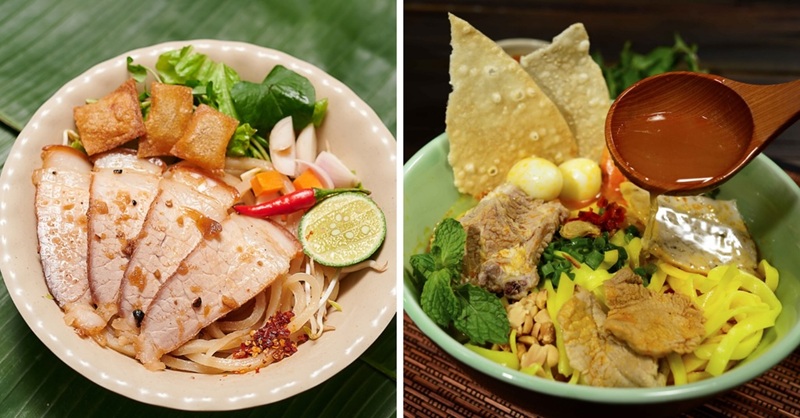
While often mistaken for other Vietnamese noodle dishes, particularly the regional Mi Quang, Cao Lau possesses several distinct characteristics that set it apart. The following table highlights the core differences between Cao Lau and Mi Quang:
|
Feature |
Cao Lau |
Mi Quang |
|
Noodle Preparation |
Complex: uses lye water from Cua Lao Cham wood ash and must be mixed/ground with water from the specific Ba Le well. The process involves multiple steaming and drying steps. |
Simpler: made from rice flour, colored with turmeric (yellow) or other natural dyes. |
|
Noodle Appearance |
Slightly opaque/darker, chewier, and firmer. |
Brighter, softer, and smoother. |
|
Broth/Liquid |
Very little liquid, more of a sauce or concentrated gravy derived from the xa xiu meat, resulting in a richer, thicker consistency. |
Clear, light broth/soup, usually from slow-simmered chicken or pork bones. |
|
Primary Topping |
Mainly xa xiu (char siu) pork and crispy squares of pork rind/croutons. |
Diverse: pork, chicken, shrimp, quail eggs, duck, frog, or fish. |

Compared to Pho, the distinction is even clearer: Pho features a large amount of clear, aromatic broth, thin rice noodles, and relies on fresh herbs and lime for flavor. Cao Lau is a dish with minimal liquid (more like a dry noodle salad), thicker, chewier noodles, and a dominant xa xiu flavor profile, making it a truly unique culinary experience in Vietnam.
1.3 The Role of Ba Le Well and the Unique Cao Lau Noodles
The exceptional quality and texture of Cao Lau noodles are famously linked to two essential, localized ingredients:
- Lye Water (nước Tro Tàu): The rice used for the noodles must be soaked in lye water, which is exclusively prepared from the ash of a specific type of wood found on Cua Lao Cham island near Hoi An. This step gives the noodles their characteristic texture and slight chewiness.
- Ba Le Well Water (nước giếng Bá Lễ): The rice flour must be ground using water drawn from the ancient Ba Le Well in Hoi An. Local legend and tradition hold that only the cool, clear, and mineral-rich water from this well can impart the correct flavor and suppleness to the noodles, a secret guarded by the local cooks.
This meticulous sourcing of ingredients is why authentic Cao Lau is believed to only be truly enjoyed in Hoi An, as the very "soul" of the dish depends on its geography. The name "Cao Lau" itself, meaning "high story" or "upstairs," is also unique, referring to the tradition of serving the dish on the second floors of restaurants, offering diners a view of the peaceful ancient town.
2. Best Places to Try Authentic Cao Lau in Hoi An
To truly appreciate the unique flavor and preparation of Cao Lau, you must taste it in Hoi An. The following is a selection of the best and most authentic spots, ensuring you experience the true culinary soul of the ancient town.
2.1 Cao Lau Ba Be – a Local Favorite with Affordable, Authentic Flavors
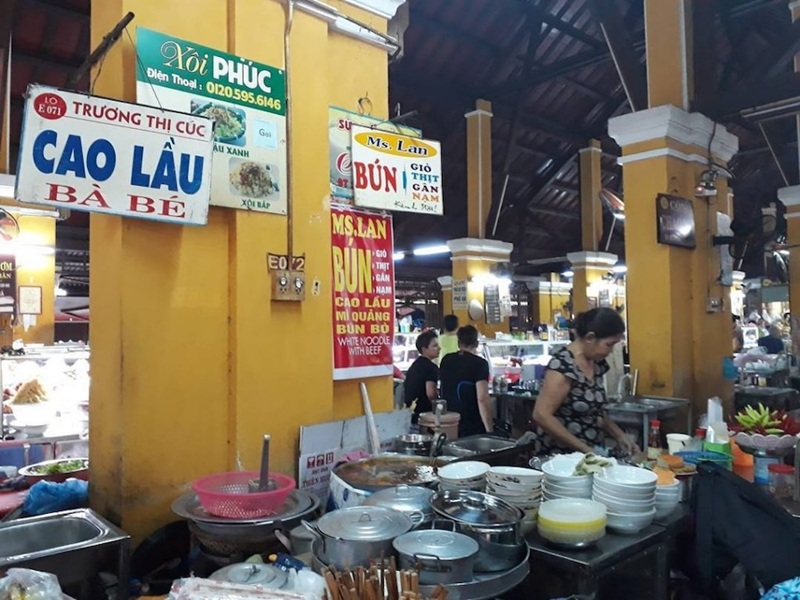
Cao Lau Ba Be is a small stall located inside the food court of Hoi An Market. Despite its humble, casual setting, it is highly recommended by many tourists, being a very familiar dining address. The Cao Lau here is known for its soft yet firm noodles served with savory xá xiu pork, crispy fried pork skin, peanuts, and fresh herbs, all at a very reasonable price.
- Address: Food Court, Hoi An Market, Tran Phu Street, Hoi An.
- Opening Hours: 2:00 PM – 10:00 PM
- Price Range: Approx. $0.80 – $1.80 USD (20,000 – 45,000 VND)
2.2 Trung Bac Restaurant – One Of The Oldest Spots Preserving Tradition
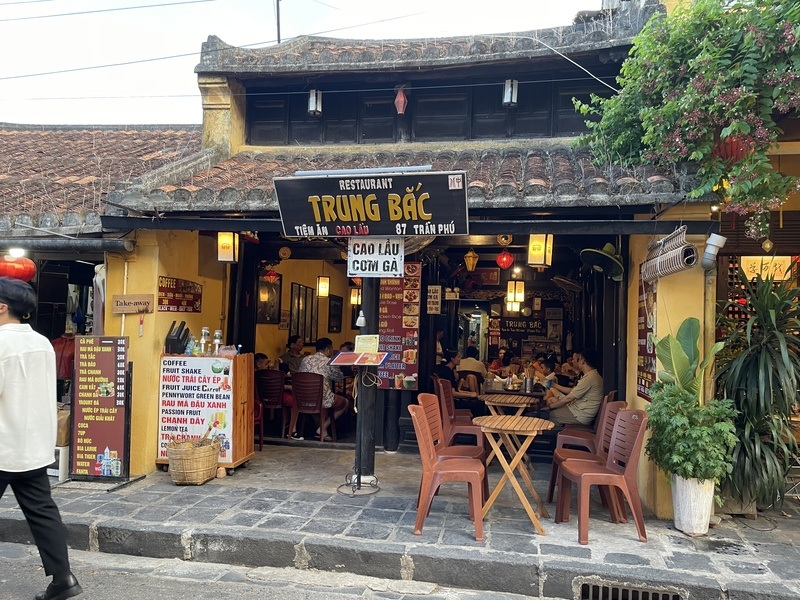
For a taste of history, look no further than Trung Bac restaurant at 87 Tran Phu Street. With a history spanning over 100 years, Trung Bac is considered one of the guardians of traditional Cao Lau preparation. The noodles here are famously soft yet delightfully chewy, and the xá xíu meat is expertly sliced and intensely flavorful. Its longevity and central location near the Ancient Town make it a convenient and essential stop to experience the dish as it was prepared generations ago.
- Address: 87 Tran Phu Street, Hoi An.
- Opening Hours: 7:30 AM – 10:00 PM
- Price Range: Approx. $1.60 – $2.40 USD (40,000 – 60,000 VND)
2.3 Lan Eatery – Famous for its Special Combo of Cao Lau and Đập Cake
Located in Cam Nam, the eatery offers a distinct experience. While the Cao Lau itself is excellent, Lan Eatery is best known for its very affordable combo meals that pair Cao Lau with other local specialties, particularly Đập cake (smashed rice paper) and chè bắp (corn sweet soup). Its location by the river provides a breezy, comfortable atmosphere, making it a perfect spot for a relaxed, authentic meal away from the central bustle.
- Address: Cam Nam, Hoi An. (Look for the main eatery in the Cam Nam area).
- Opening Hours: 7:00 AM – 10:00 PM
- Price Range: Approx. $0.40 – $2.00 USD (10,000 – 50,000 VND)
2.4 Cao Lau Hai Toan – A Humble Eatery Loved by the Locals
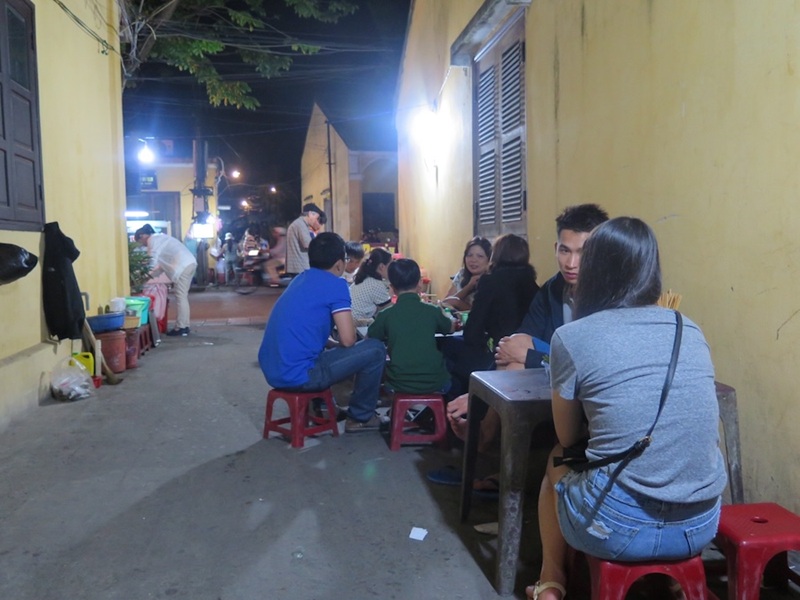
Situated on Phan Chu Trinh Street, Cao Lau Hai Toan is a quintessential local spot. Operating primarily in the late afternoon and early evening, this humble establishment, often just a simple sidewalk vendor setup, is where many locals go for their quick fix. The flavors are consistently praised as being true to the Quang Nam region, simple, satisfying, and offered at a highly competitive price.
- Address: 27 Phan Chu Trinh Street, Hoi An.
- Opening Hours: 3:00 PM – 8:00 PM
- Price Range: Approx. $0.80 – $1.40 USD (20,000 – 35,000 VND)
2.5 Cao Lau Lien – Well-known for Chewy Noodles and Rich Broth

Compared to many other eateries in Hoi An, Cao Lau Lien is said to offer visitors the most distinctive culinary aftertaste. The Cao Lau noodles are famously made using water from the Ba Le well and follow the original, authentic Quảng Nam recipe, resulting in a dish that is very delicious and satisfying for both locals and tourists.
- Address: 16 Thai Phien Street, Hoi An.
- Opening Hours: 1:00 PM – 9:00 PM
- Price Range: Approx. $1.00 – $1.80 USD (25,000 – 45,000 VND)
2.6 Khong Gian Xanh (Green Space) – Cozy Setting with Rustic Charm
Khong Gian Xanh is known for offering a high-quality bowl of Cao Lau in a very pleasant, green, and airy setting. While the price is slightly above the street stalls, the comfortable environment, the clean preparation, and the consistent, authentic flavor make it a great option for those seeking a more relaxed and welcoming dining experience.
- Address: 687 Hai Ba Trung Street, Hoi An.
- Opening Hours: 7:30 AM – 8:30 PM
- Price Range: Approx. $1.20 – $2.00 USD (30,000 – 50,000 VND)
2.7 Hoi An Market – the Best Place to Enjoy Diverse, Local-style Cao Lau
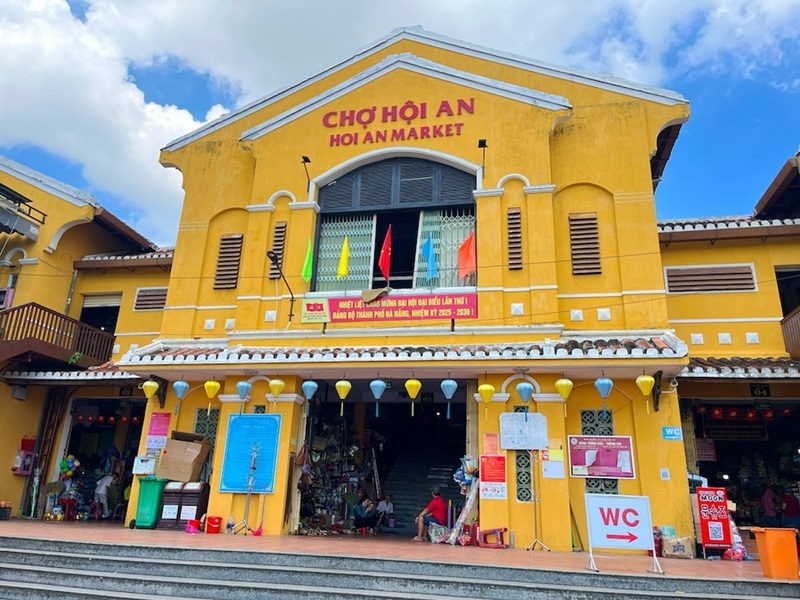
Hoi An Market is viewed as a culinary paradise that every visitor should explore. Not only can you enjoy delicious and affordable Cao Lau, but you can also comfortably shop for various famous specialties to take home as gifts after your trip.
- Address: Intersection of Bach Dang, Tran Phu, and Nguyen Thai Hoc Streets, Hoi An.
- Opening Hours: 6:00 AM – 10:00 PM
- Price Range: Approx. $0.60 – $1.20 USD (15,000 – 30,000 VND)
2.8 Quan Bon – Serving both Mi Quang and Cao Lau for Variety
Many diners consider Quan Bon a "must-try" spot because of its prime location near Hoi An beach. Enjoying a piping hot bowl of Cao Lau right after swimming is an unforgettable memory. The owner has slightly adjusted the Cao Lau recipe to better suit the palates of tourists, making it a highly rated spot.
- Address: 474 Cua Dai Street, Hoi An.
- Opening Hours: 7:00 AM – 3:00 PM
- Price Range: Approx. $0.80 – $2.00 USD (20,000 – 50,000 VND)
2.9 Ba Le Restaurant – Tied to the Historic Ba Le Well

If you are looking for a place that serves Cao Lau all day, you should visit Ba Le Restaurant. The eatery stays open late and is always bustling with customers. The Cao Lau servings are full of toppings, and the ingredients are primarily selected by the owners, ensuring freshness and safety. It is praised for its professional service.
- Address: 49/3 Tran Hung Dao Street, Hoi An.
- Opening Hours: 11:00 AM – 10:00 PM (Mon-Fri); 7:00 AM – 10:00 PM (Sat-Sun)
- Price Range: Approx. $0.80 – $1.80 USD (20,000 – 45,000 VND)
2.10 Tam Quang Minh – Vegetarian Cao Lau with Light, Wholesome Taste
Tam Quang Minh has long been famous as the best vegetarian restaurant in Hoi An. Besides its vegetarian Cao Lau, which retains its characteristic flavor, the restaurant also offers other specialties like bánh xèo, bún táo, and Mi Quang, allowing you to comfortably enjoy various local dishes.
- Address: 33 Ly Thai To Street, Hoi An.
- Opening Hours: 6:00 AM – 10:00 PM
- Price Range: Approx. $0.60 – $2.00 USD (15,000 – 50,000 VND)
2.11 Cao Lau Ba Thanh – A Small Yet Always Bustling Local Shop

Ba Thanh’s eatery has a history of over 30 years. The ingredients are carefully selected by the owner, making it a recommended spot to enjoy the authentic Quang Nam flavor. The Cao Lau is delicious, with a rich and distinctive taste. Though the space is small, it remains a busy, popular choice.
- Address: 26 Thai Phien Street, Hoi An.
- Opening Hours: 7:00 AM – 7:00 PM
- Price Range: Approx. $1.20 – $1.80 USD (30,000 – 45,000 VND)
2.12 Cao Lau Phuc – Unique with Both Cao Lau and Chicken Rice on the Menu
Cao Lau Phuc is a small eatery located on Phan Chu Trinh Street that consistently attracts a large number of diners every day. The Cao Lau noodles here are very chewy and delicious, with a unique taste. The xa xiu pork is also very rich in flavor, and the owner often gives extra herbs or fried pork rinds to ensure diners enjoy the dish fully.
- Address: 11 Phan Chu Trinh Street, Hoi An.
- Opening Hours: 10:00 AM – 9:30 PM
- Price Range: Approx. $0.80 – $1.80 USD (20,000 – 45,000 VND)
Cao Lau is more than just a meal; it’s an irreplaceable part of Hoi An’s heritage, shaped by its mysterious origins and strict adherence to local ingredients. Cao Lau is the perfect way to connect with the unique culture and history of this beautiful destination. Don’t leave Hoi An without trying this local delicacy – it’s an experience you won’t soon forget. Follow Hoi An Memories Land to learn more about the culture and special features of the Faifo trading port.
-
Hotline: 1900 63 66 00
-
Press 1 For tickets
-
Press 2 For Customer Service
Latest news
![Over 30 Unique Things To Do In Hoi An Viet Nam [Monthly Update]](public/media/thumb/dao-ky-uc-hoi-an-la-mot-quan-the-du-lich-nghi-duong-van-hoa-nam-ngay-canh-pho-co1-90x90.jpg)
Over 30 Unique Things To Do In Hoi An Viet Nam [Monthly Update]

Where to Stay in Hoi An? Essential Tips for Choosing the Ideal Accommodation for First-Timers

Discover the Chinese Assembly Halls in Hoi An: Cultural Icons of the Ancient Town

Hoi An Specialties by Season: What to Eat Throughout the Year













Comment